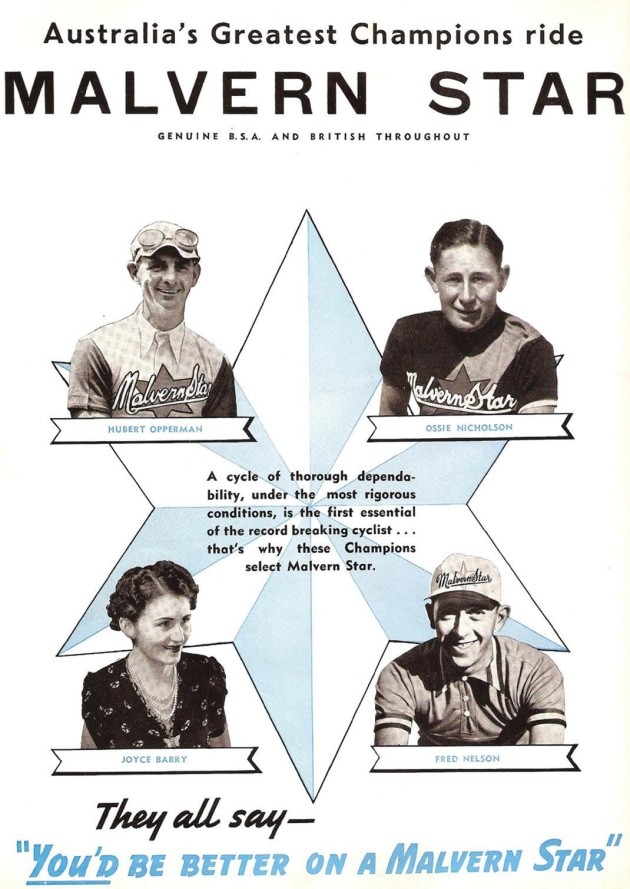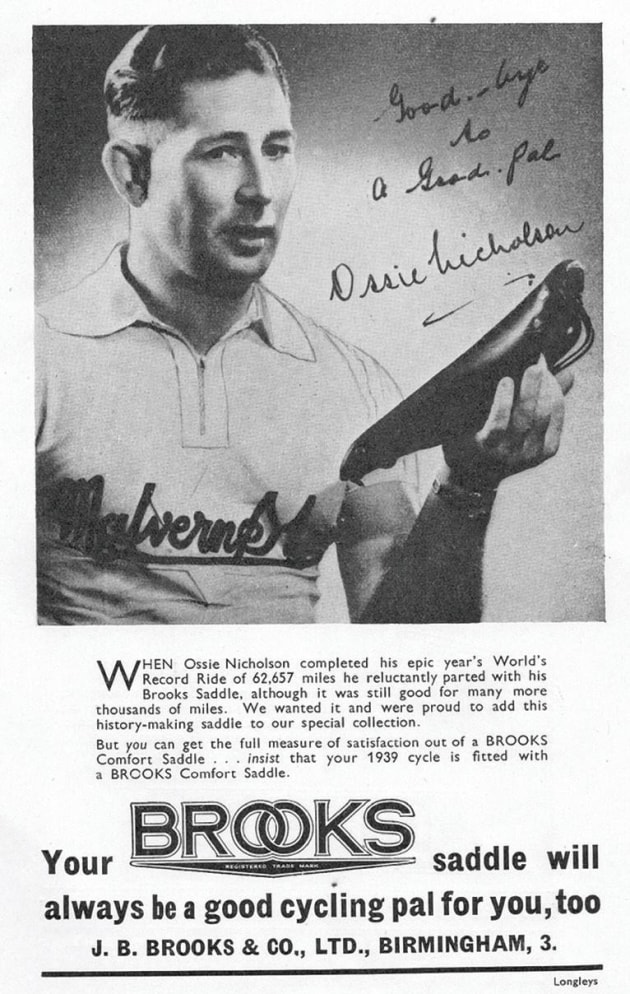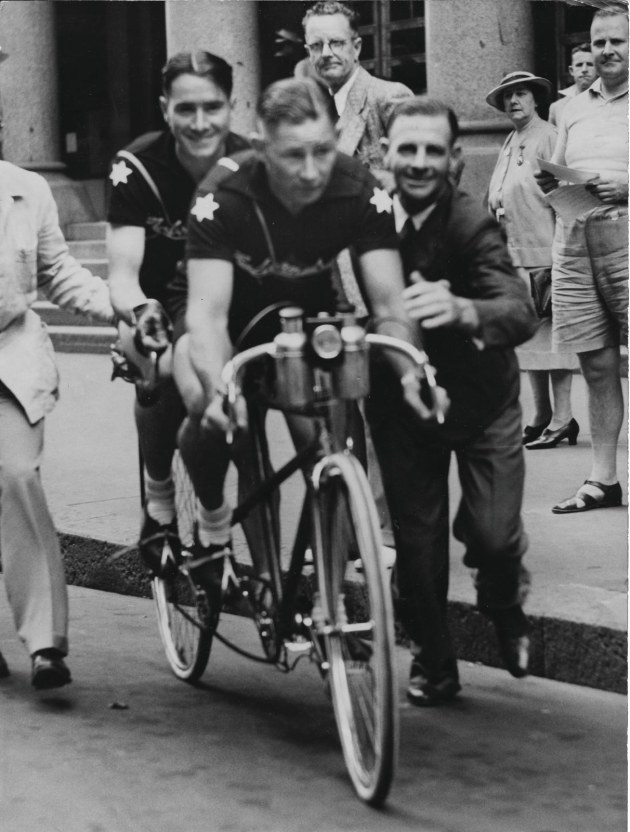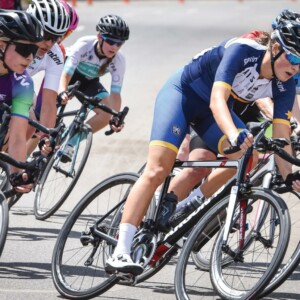These days endurance cycling records are a dime a dozen. But the best part of a century ago, a former Australian Tour de France combatant by the name of Ossie Nicholson was blazing his own trails, very long trails. Peter Maniaty explores his story.

In the long and winding road of cycling history, only nine people have held the world record for distance ridden solo in a single calendar year. Four Brits, two Frenchmen, two Americans and a lone Australian, who actually broke the record twice, Oserick Bernard ‘Ossie’ Nicholson.
The current mark was set by America’s Amanda Coker who, just two years ago, travelled 139,269km at a mind-bending average of 381km per day. While Coker’s achievement was epic in every way imaginable, when judging it against the feats of her predecessors, it’s important to view it through the appropriate prism of history. For example, her attempt was fully supported on a closed and virtually flat course on the outskirts of Tampa in Florida, using lightweight modern equipment and the finest in 21st Century sports science and nutrition. By way of contrast, almost exactly 90 years before Coker, riding with scant support on pot-holed open roads, using heavy steel bicycles with limited gearing, Ossie Nicholson covered a whopping 100,837km in 1937.
That’s 276km per day, every day, on a bike that weighed in the vicinity of 20kg. For an entire year.
Of course, in Nicholson’s favour was the fact the 1930s were halcyon days for endurance cycling. The annual distance record captured the imagination of the public in western Europe, as well as the Antipodes, with the mark changing hands on eight separate occasions before the
onset of World War Two.
Nicholson first set the record in 1933, however his distance of 70,756km was eclipsed by more than 2,000km in 1936 by an outspoken tee totalling Yorkshireman with only one arm, Walter Greaves. Not to be outdone, Nicholson immediately set about making plans to reclaim it, and duly did. In fact, by the end of 1937 he became the third rider to break the record in that one year. Alas, his second stay as record-holder was even more short-lived, with not one but two British riders – Bernard Bennett and then Tommy Godwin – setting new marks in 1939. Remarkably, Godwin’s distance of 120,825km remained untouched until 2015.
Early days

Ossie Nicholson’s endurance efforts brought him much fame. But they weren’t the first, or only, times he found himself in the cycling spotlight. Born in New Norfolk about 30km north-west of Hobart, Nicholson moved to Victoria in his teens and learned his two-wheeled trade with the Prahran Amateur Cycling Club in Melbourne. A blacksmith’s striker by trade, he turned professional in 1928 and came to the attention of Malvern Star shortly after, beating a quality field in the crash-marred Wangaratta to Melbourne road race of 1929. Significantly, it was the first major victory in an ongoing – and often strained – rivalry with Opperman that lasted most of his career.
Nicholson married in 1929 and then, as a 24-year old, delivered a string of record-breaking performances in 1930. This included smashing the Australian one-hour motor-paced record (previously held by Opperman) by more than two miles, as well as setting a new record for the 671km journey between Canberra and Melbourne, completing the trip in 26 hours
19 minutes.
The following year, with the full backing of his sponsors at Malvern Star, Nicholson was chosen to make the long sea voyage to Europe as part of the combined Australian/Swiss team for the 1931 Tour de France, riding alongside Opperman and Richard ‘Fatty’ Lamb. However what should have been the defining race of his career instead ended in bitter disappointment, with a broken crank seeing Nicholson forced to abandon after just three stages. Things hardly improved on his return to Australia with 1932 providing even more frustration. A dearth of results on the bike were further compounded by the breakdown of his three-year marriage.
Into this void, however, came the almost-mythical Malvern Star businessman (and future Mayor of the Gold Coast) Sir Bruce Small who – after having the same offer rejected by Opperman – suggested Nicholson consider an attempt at the year distance record. At the time it was held by British rider Arthur Humbles at 57,948km. News reports from the time suggest Nicholson was initially far from convinced. But Small – no doubt sensing a promotional bonanza for Malvern Star which had recently introduced a new three-gear derailleur in partnership with the Cyclo Gear Company – was relentless in his pursuit of the idea and planning duly began in the final weeks of 1932 for an attempt that would require Nicholson to cover at least 100 miles every day of 1933.
Attempt 1: 1933
According to Dave Barter in the book, “The Year: Reawakening the legend of cycling’s hardest endurance record”, Nicholson’s first shot at the record began at the Melbourne GPO just after dawn on New year’s Day in 1933. His official on-road support team comprised just one person: a local police constable who, aside from doubling as his coach, was tasked with providing massage and ‘encouragement’ at the end of each day.
Given his attempt had come about so quickly, Nicholson had little time for specific training and struggled during the initial stages in the scorching summer heat. “I have undertaken my current task, which is so long-term, without any special training,” Nicholson told the media of the day according to a 1999 article by Ron Shepherd of the Canberra Bicycle Museum & Resource Centre. “Right up to the end of 1932, to the day before I attacked the 365 day record, I was racing on the track. Also, at the start, covering 160 kilometres each day was to me an agony, and I stopped at every stream to plunge into the fresh water.”
Growing sponsor commitments – actively encouraged by the entrepreneurial Small – proved another frequent distraction, with Nicholson quickly assuming celebrity status thanks to his daily presence on the local roads between Melbourne and Portsea. Despite easing his fierce initial tempo, Nicholson was still averaging 115 miles (184km) per day by mid-March. This placed him well ahead of Humbles’ schedule and he was able to maintain that pace deep into the Australian autumn.

Winter proved a very different beast, with the testing Victorian weather causing many crashes and several bouts of influenza. Regardless, Nicholson pressed on, prompting ‘The Referee’, a Sydney-based newspaper published until 1939, to write: “Facing the winter conditions with the pluck and determination that characterised the Australian’s efforts in the Tour de France, Ossie Nicholson has come through (winter) with flying colours in his attack on the world’s 12 months’ record. In Nicholson, Australia undoubtedly possesses a great marathon rider with a big heart.”
By late spring that big heart had already propelled Nicholson beyond the previous world record, surpassing Humbles’ mark on 30 October 1933. He paused to be presented with a sash and victory cup outside Bruce Small’s bike shop. He then promptly hopped back on his bike and kept going. How far could he travel before year’s end?
More drama was to come however, with Nicholson hit by a car on December 12. But even that wasn’t enough to stop him and after discharging himself from hospital he got back on his bike. His history-making year finally came to an end as he dismounted in front of 20,000 adoring well-wishers on December 31. In addition to his world record for annual distance covered, Nicholson had also set a new mark for riding 100 miles or more for 365 consecutive days. For his Herculean efforts, Nicholson is said to have received £25 and a gold watch. According to The Referee, Nicholson also mysteriously received: “an annual monetary grant from a leading sportsman in England during the period in which he held the world’s record.”
Attempt 2: 1937
While Nicholson’s original record saw him ride from Melbourne to Portsea and back every day of 1933, the distance ante had been upped considerably in 1937. Older, wiser and better prepared, he planned to cover the same course twice each day in his attempt to break Walter Greaves’ new world mark of 73,037km, set in 1936. Adding further spice to proceedings, two European riders were also simultaneously attacking Greaves’ record on the other side of the globe – a fresh faced 19-year old from Great Britain, Bernard Bennett, and 48-year old French veteran, Rene Menzies, described as “a dogged type of marathon rider, with a heart like a lion.” Long before the age of online dot-watching – telegraph cables were the only way to keep track of the riders’ progress – endurance cycling had never seen anything quite like it.
Unlike 1933, Nicholson had prudently negotiated greater logistical support from Bruce Small and his long-time backers at Malvern Star. This time he was to be accompanied by a support car carrying a ready supply of food, spares and bikes. He was also accompanied by a new nickname, ‘Tiger of the Road.’
Nicholson’s initial target was set at an average of 240 km per day. But, on starting just after midnight on New Year’s Day, cheered by a large crowd celebrating new year’s eve, he set a ferocious pace, averaging closer to 300km per day despite suffering severe saddle soreness. Unsurprisingly, Nicholson quickly developed a lead over both rivals which he held for many months, making the most of the more favourable southern hemisphere weather.
The challenge of 19-year old Bennett, whilst impressive for his young years, faded. However as the year wore on and the Victorian winter and European summer took hold, Menzies began to steadily narrow the gap and, remarkably, by October 1937 it was neck and neck. Reports even suggest, somewhat serendipitously, both riders passed Greaves’ previous record on the exact same day. True or not, the race was on. However, as the weather again began to turn, the contest swung back in Nicholson’s favour.
By the end of the 1937 calendar year, all three challengers had bettered Greaves’ previous world mark. Bennett had ridden 73,710 km. Menzies 99,073km. But Nicholson had trumped them both, stepping off his bike on New Year’s Eve having set a new mark of 100,837km and, in doing so, becoming the first rider to register six figures (metric) in a single calendar year. But his riding wasn’t finished just yet. As The Telegraph reported on January 1, 1938: “Nicholson finished his 12 month’s ride officially on Friday at midnight, but he must cycle on at reduced speed for at least two weeks in what is known as a ‘training off’ period. It would be highly injurious for a rider to stop suddenly after 12 months of pedalling.”
Even then he didn’t stop breaking records, mind you. In June 1938 Nicholson set the Australian men’s seven-day record, covering 2,425km (346km every day for a week!) on a 35km circuit through the streets of Adelaide. Post-cycling he continued to work for Malvern Star and oversaw the production of radio location devices for the RAAF during World War Two. He was also known to perform in stage productions, once playing the character of Henry VIII, before touring New Zealand as a member of an Italian choir.
He liked it so much he decided to stay across the Tasman where he, reportedly, died of a heart attack in 1965, aged 59.
Words: Peter Maniaty.


